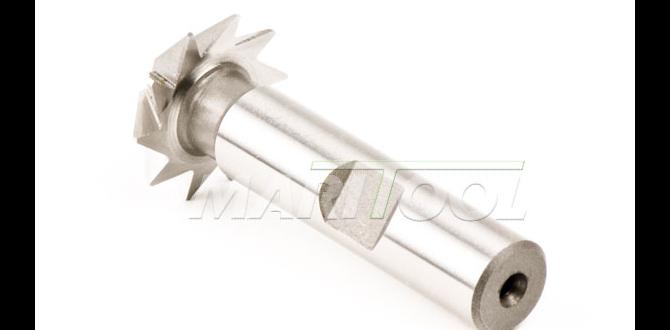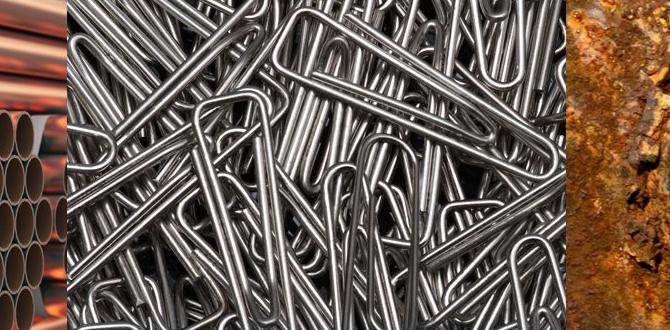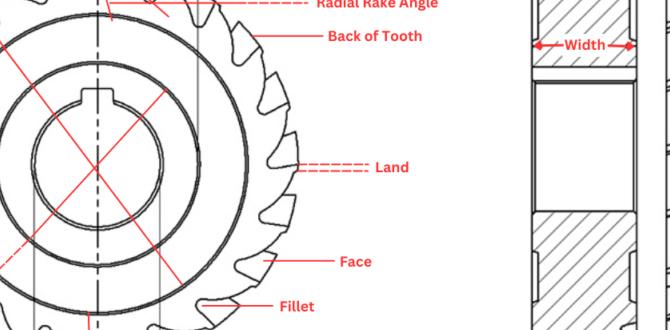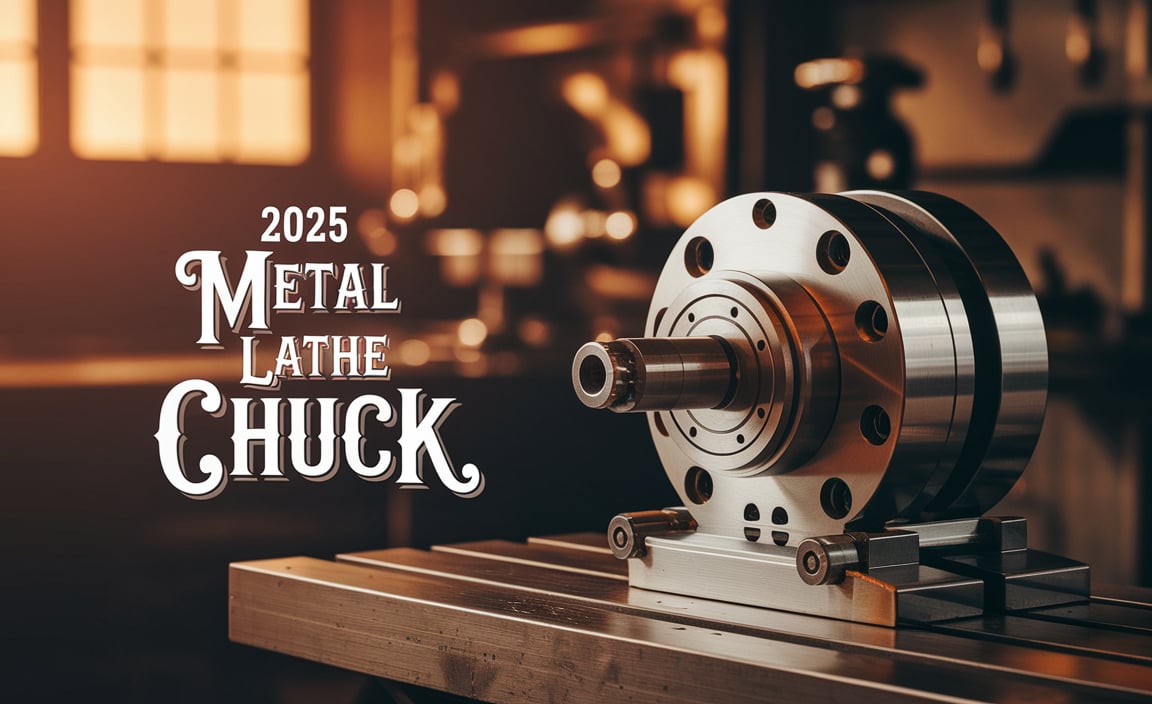Have you ever watched a metal lathe spin? It’s like magic as the tool shapes metal into beautiful creations. Lathe workholding is a vital part of this process. But what does it really mean? Understanding lathe workholding can make all the difference in metal lathe operations.
Imagine trying to carve a statue from a block of stone. If your stone isn’t held tightly, you’ll end up with a mess. The same is true for lathe workholding. It keeps the metal in place while the lathe operates. Without it, the metal could slip or even fly off!
Did you know that skilled machinists can make tiny parts that fit together like a puzzle? It all starts with good lathe workholding. Using the right clamps or chucks helps ensure the metal stays put. This not only saves time but also improves safety.
As we dive deeper into this topic, you’ll discover tips to enhance your metal lathe operations. Plus, you’ll learn how the right techniques can turn a good project into a great one. Are you ready to explore the world of lathe workholding?
Effective Lathe Workholding For Precision Metal Lathe Operations Lathe Workholding Is A Critical Aspect Of Metal Lathe Operations, Ensuring That The Workpiece Is Securely And Accurately Held During Machining Processes. Proper Workholding Maximizes Precision, Reduces The Risk Of Defects, And Enhances The Safety Of Metalworking Activities. This Article Will Explore Various Workholding Techniques, Tools, And Tips Essential For Achieving Optimal Results In Lathe Operations. Understanding Lathe Workholding In Lathe Operations, Workholding Refers To The Methods Used To Secure The Workpiece While It Is Being Turned, Cut, Or Machined. The Choice Of Workholding Device Can Significantly Influence The Outcome Of The Operation, Affecting Accuracy And Efficiency. Common Workholding Devices 1. **Chucks:** Chucks Are Perhaps The Most Common Workholding Devices Employed On Lathes. They Come In Various Forms, Including Three-Jaw And Four-Jaw Chucks. Three-Jaw Chucks Automatically Center The Workpiece, Making Them A Popular Choice For Cylindrical Objects. Four-Jaw Chucks Offer Greater Flexibility For Irregular Shapes But Require Manual Centering. 2. **Collets:** Collets Provide Precision Clamping And Are Widely Used For Small, Round Workpieces. They Offer A High Degree Of Accuracy And Repeatability, Making Them Suitable For Tasks Requiring Tight Tolerances. 3. **Faceplates:** For Larger Workpieces, Faceplates Can Be Utilized. These Devices Attach Directly To The Lathe Spindle And Allow For Mounting Of Larger, Irregularly Shaped Workpieces Using Clamps Or Bolts. 4. **Fixtures:** Special Fixtures Can Be Designed For Unique Machining Requirements, Providing Additional Support And Enhancing The Stability Of The Workpiece During Operation. Tips For Effective Workholding – **Proper Setup:** Learn How To Set Up And Align Your Workholding Devices Correctly To Prevent Shifting During Machining, Which Can Lead To Inaccuracies Or Damage To The Workpiece. – **Choose The Right Device:** Select The Appropriate Workholding Solution Based On The Workpiece’S Size, Shape, And Material. – **Maintenance:** Regularly Inspect And Maintain Workholding Devices To Ensure Optimal Performance And Safety. – **Test Runs:** Conduct Test Runs When Working With New Setups To Ensure Quality And Precision Before Proceeding With The Actual Machining Job. Conclusion Mastering Lathe Workholding Techniques Is Essential For Anyone Involved In Metal Lathe Operations. By Utilizing The Right Devices And Applying Effective Practices, Machinists Can Achieve Precision Results While Enhancing Safety And Efficiency In Their Projects. Whether Working With Traditional Chucks, Collets, Or Custom Fixtures, Understanding The Nuances Of Workholding Can Significantly Influence The Quality Of Final Products.

Lathe Workholding and Metal Lathe Operations
Lathe workholding is essential for precise metal lathe operations. Properly securing the workpiece helps ensure accuracy while shaping or cutting metal. Different tools like chucks, vises, and clamps hold materials in place. Did you know that even a slight misalignment can lead to errors? By learning correct techniques, you can achieve better results and save time. Mastering this skill opens doors to creative and practical projects. Are you ready to explore the world of lathe workholding?Importance of Workholding in Metal Lathe Operations
Role of workholding in achieving precision. Impact on productivity and safety in machining.Using the right workholding is key in metal lathe operations. It helps keep the material still, which leads to better accuracy. This means fewer mistakes. Precision is vital for making parts that fit well. Good workholding also boosts productivity. Workers can complete tasks faster and safer, which makes everyone happy. Furthermore, it reduces accidents by holding materials securely. Always use the right tools for the job!
Why is workholding important for safety?
Good workholding prevents accidents by ensuring materials do not move unexpectedly. This keeps workers safe. Using proper tools also boosts efficiency, making work easier and quicker.
Types of Workholding Devices for Metal Lathes
**Chucks**: Types (threejaw, fourjaw, etc.) and their uses. **Faceplates and Mandrels**: When to use and advantages.There are several fun ways to hold metal while using a lathe. One popular option is the chuck. Chucks can have either three or four jaws. The three-jaw chuck is great for quick and easy setups, while the four-jaw chuck gives you more control for odd shapes. Both types are champions in holding metal tight and steady!
Another option is the faceplate. It’s like a flat table for your metal. Faceplates are useful when you need to secure larger pieces that are hard to clamp. The mandrel is also handy for long, skinny parts, keeping them in place while you work. Who knew metal lathes could be such a fun party with all these tools?
| Device | Type | Use |
|---|---|---|
| Chuck | Three-Jaw | Easy setup, good for round pieces |
| Chuck | Four-Jaw | Better for irregular shapes, more control |
| Faceplate | N/A | Holds large workpieces |
| Mandrel | N/A | Used for long, slender parts |
Setting Up Workholding Devices
Stepbystep guide to installing chuck systems. Tips for securing workpieces accurately.Installing a chuck system on your lathe is easy. Here’s how to do it step by step:
- First, clean the lathe’s spindle.
- Next, place the chuck onto the spindle.
- Tighten it using the key or handle provided.
- Finally, check if it spins smoothly.
To secure your workpiece accurately, follow these tips:
- Always center the piece in the chuck.
- Use soft jaws if your piece is delicate.
- Check tightness before starting.
Using these steps, you can make your metal lathe operations safe and effective!
How do you secure a workpiece in a lathe?
To secure a workpiece in a lathe, you should center it in the chuck, tighten it evenly, and double-check its fit to avoid any mishaps during operation.
Advanced Workholding Techniques
Utilizing fixtures and jigs for complex shapes. Collet systems and their benefits for precision.Need to hold tricky shapes while working on a lathe? Fixtures and jigs are your best friends! They keep everything steady, so you won’t accidentally turn a wheel into a banana shape! Next, let’s talk about collet systems. They grip workpieces tightly, making them perfect for precision. Imagine trying to carve a statue with slippery clay—impossible! With collets, you get consistent results every time. Trust me; they’re like having a super strong arm on your lathe.
| Technique | Benefit |
|---|---|
| Fixtures and Jigs | Holds complex shapes in place |
| Collet Systems | Ensures precision and tight grip |
Common Challenges in Workholding
Issues with workpiece stability and how to address them. Troubleshooting common workholding problems.Holding onto workpieces in lathe operations can feel like trying to catch a greased pig! Stability issues are common, and if your workpiece wobbles, you’ll end up with more mess than masterpiece. To fix this, always check your clamps and add some extra support. The right setup can save the day!
| Problem | Solution |
|---|---|
| Wobbly workpiece | Use two clamps instead of one |
| Slipping jaws | Clean and adjust the jaws |
| Uneven pressure | Rotate the workpiece while tightening |
When troubleshooting, always start with the basics. Check for dirt and wear. Remember, a clean machine is a happy machine! If problems persist, don’t hesitate to redo the setup. A little patience goes a long way—just like waiting for your favorite pizza to bake!
Best Practices for Effective Metal Lathe Operations
Strategies for improving accuracy and efficiency. Maintenance tips for workholding devices.For great metal lathe work, start with a solid plan. Use calipers and micrometers to measure accurately. Check each setting before you cut. Remember, missing a tiny measurement can turn your masterpiece into a lumpy paperweight! Don’t forget to keep your workholding devices clean. A little oil and a quick wipe can make a big difference. Regular maintenance helps your lathe last longer too. It’s like giving it a spa day!
| Maintenance Task | Frequency |
|---|---|
| Clean workholding devices | After each use |
| Oil moving parts | Weekly |
| Check alignment and settings | Before major projects |
Safety Considerations in Metal Lathe Workholding
Essential safety practices when using workholding devices. Identifying hazards and minimizing risks in lathe operations.Working with a metal lathe can be fun, but safety always comes first. Using workholding devices correctly helps prevent accidents. Here are some essential safety practices:
- Always wear safety goggles to protect your eyes.
- Check all devices for damage before use.
- Secure your workpiece tightly to avoid slipping.
- Keep hands away from moving parts.
- Maintain a clean workspace to reduce hazards.
Identifying hazards can help minimize risks. Things like loose clothing or long hair can get caught in the machine. Always be aware of your surroundings while working. Remember, safety is the best way to enjoy metal lathe operations!
What are the key safety tips for metal lathe workholding?
Some key safety tips include securing your material, wearing protective gear, and keeping a clear workspace. Always check your equipment for any damage before starting work. Staying safe helps you work better and enjoy your projects!
Future Trends in Lathe Workholding Technology
Innovations in workholding solutions. The role of automation in modern lathe operations.Innovations are changing how we hold workpieces in metal lathes. New materials and designs improve grips. Workholding solutions are now faster, stronger, and smarter. Automation plays a big role here. Machines can now adjust quickly, making production smoother and efficient. As technology evolves, these changes help manufacturers save time and money.
What are the benefits of automation in lathe operations?
Automation makes lathe operations faster and more precise. Machines can run without constant human input, leading to fewer mistakes.
Key Benefits of Automation:
- Less waste of materials
- Higher production speeds
- Consistent quality of parts
- Improved safety for workers
Conclusion
In summary, lathe workholding is crucial for successful metal lathe operations. Properly securing materials helps create precise and safe cuts. Remember to choose the right clamps or chucks for your project. Experiment with different techniques to find what works best for you. If you’re interested, explore more about lathe types and settings to enhance your skills!FAQs
Sure! Here Are Five Related Questions On The Topic Of Lathe Workholding In Metal Lathe Operations:Sure! Here are five questions about how to hold metal pieces when using a lathe: 1. What is a lathe? A lathe is a machine that spins metal to cut it into shapes. 2. Why do we need workholding? We need workholding to keep the metal piece still while we shape it. 3. What tools can we use for workholding? We can use chucks, clamps, and vices to hold the metal. 4. How do you choose the right workholding tool? You choose based on the shape and size of the metal piece you’re working on. 5. Can I make my own workholding tools? Yes, you can! You can use simple materials to create your own holding tools.
Sure! Just let me know what question you want me to answer.
What Are The Different Types Of Workholding Devices Used In Metal Lathe Operations, And What Are Their Specific Applications?In metal lathe operations, we use different tools to hold our pieces of metal steady. One type is a chuck, which grips round pieces like pipes. Another type is a faceplate, good for flat pieces that need turning. We also have collets, which hold small parts tightly. Each device helps us work safely and accurately on metal.
How Does The Choice Of Workholding Method Affect The Precision And Accuracy Of Turned Parts In Lathe Machining?Choosing the right workholding method is really important when using a lathe, which is a tool that spins parts to shape them. If you hold the part tightly and securely, it will stay in place better. This helps make sure the part is shaped correctly, making it more accurate. If the part moves around while being cut, it can create errors. So, good workholding means better finished parts!
What Are The Best Practices For Securing Irregularly Shaped Workpieces In A Metal Lathe To Prevent Movement During Machining?To secure oddly shaped pieces in a metal lathe, first, use a strong vise to hold them tight. You can also use clamps to keep them from moving. Placing soft material, like rubber, between the piece and the vise helps grip better. Always check that everything is secure before you start working. This way, you keep your workpiece safe while you machine it!
How Can Vibrations During Lathe Operations Impact Workholding And The Overall Quality Of The Machined Component?Vibrations during lathe operations can make it hard to hold the piece you are working on. If the piece moves or shakes, it can create rough edges or mistakes in the shape. This means the final product might not fit together well or work properly. We need to keep things steady to make sure everything looks good and works right. So, controlling vibrations helps us make better parts!
What Safety Considerations Should Be Taken Into Account When Setting Up And Using Workholding Systems On A Metal Lathe?When using a metal lathe, safety is very important. Always check that your workholding system is tight so parts don’t move. Make sure you wear safety glasses to protect your eyes. Keep your hands away from the sharp parts. Plus, never wear loose clothing or jewelry; they can get caught in the machine.
{“@context”:”https://schema.org”,”@type”: “FAQPage”,”mainEntity”:[{“@type”: “Question”,”name”: “Sure! Here Are Five Related Questions On The Topic Of Lathe Workholding In Metal Lathe Operations:”,”acceptedAnswer”: {“@type”: “Answer”,”text”: “Sure! Here are five questions about how to hold metal pieces when using a lathe: 1. What is a lathe? A lathe is a machine that spins metal to cut it into shapes. 2. Why do we need workholding? We need workholding to keep the metal piece still while we shape it. 3. What tools can we use for workholding? We can use chucks, clamps, and vices to hold the metal. 4. How do you choose the right workholding tool? You choose based on the shape and size of the metal piece you’re working on. 5. Can I make my own workholding tools? Yes, you can! You can use simple materials to create your own holding tools.”}},{“@type”: “Question”,”name”: “”,”acceptedAnswer”: {“@type”: “Answer”,”text”: “Sure! Just let me know what question you want me to answer.”}},{“@type”: “Question”,”name”: “What Are The Different Types Of Workholding Devices Used In Metal Lathe Operations, And What Are Their Specific Applications?”,”acceptedAnswer”: {“@type”: “Answer”,”text”: “In metal lathe operations, we use different tools to hold our pieces of metal steady. One type is a chuck, which grips round pieces like pipes. Another type is a faceplate, good for flat pieces that need turning. We also have collets, which hold small parts tightly. Each device helps us work safely and accurately on metal.”}},{“@type”: “Question”,”name”: “How Does The Choice Of Workholding Method Affect The Precision And Accuracy Of Turned Parts In Lathe Machining?”,”acceptedAnswer”: {“@type”: “Answer”,”text”: “Choosing the right workholding method is really important when using a lathe, which is a tool that spins parts to shape them. If you hold the part tightly and securely, it will stay in place better. This helps make sure the part is shaped correctly, making it more accurate. If the part moves around while being cut, it can create errors. So, good workholding means better finished parts!”}},{“@type”: “Question”,”name”: “What Are The Best Practices For Securing Irregularly Shaped Workpieces In A Metal Lathe To Prevent Movement During Machining?”,”acceptedAnswer”: {“@type”: “Answer”,”text”: “To secure oddly shaped pieces in a metal lathe, first, use a strong vise to hold them tight. You can also use clamps to keep them from moving. Placing soft material, like rubber, between the piece and the vise helps grip better. Always check that everything is secure before you start working. This way, you keep your workpiece safe while you machine it!”}},{“@type”: “Question”,”name”: “How Can Vibrations During Lathe Operations Impact Workholding And The Overall Quality Of The Machined Component?”,”acceptedAnswer”: {“@type”: “Answer”,”text”: “Vibrations during lathe operations can make it hard to hold the piece you are working on. If the piece moves or shakes, it can create rough edges or mistakes in the shape. This means the final product might not fit together well or work properly. We need to keep things steady to make sure everything looks good and works right. So, controlling vibrations helps us make better parts!”}},{“@type”: “Question”,”name”: “What Safety Considerations Should Be Taken Into Account When Setting Up And Using Workholding Systems On A Metal Lathe?”,”acceptedAnswer”: {“@type”: “Answer”,”text”: “When using a metal lathe, safety is very important. Always check that your workholding system is tight so parts don’t move. Make sure you wear safety glasses to protect your eyes. Keep your hands away from the sharp parts. Plus, never wear loose clothing or jewelry; they can get caught in the machine.”}}]}






